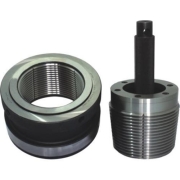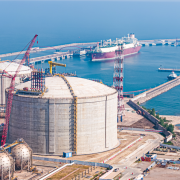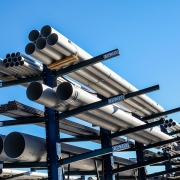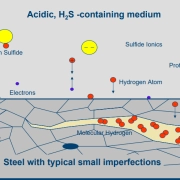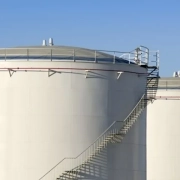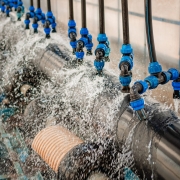API 仕様 5B と ASME B1.20.1
導入
石油、ガス、工業分野におけるねじ山と接続規格に関しては、 API 仕様 5B と ASME B1.20.1 は 2 つの重要な基準です。これらの規格は、パイプ、チューブ、継手のねじの仕様を規定し、ねじ接続の整合性、互換性、パフォーマンスを保証します。どちらもねじを標準化するという同じ一般的な目的を果たしますが、異なる技術要件と範囲を持つさまざまなアプリケーションと業界に対応しています。
API Spec 5B と ASME B1.20.1 とは何ですか?
API 仕様 5B アメリカ石油協会 (API) が発行する規格で、石油およびガス産業で使用されるケーシング、チューブ、ラインパイプのねじ接続部のねじ切り、ゲージ、テスト手順を規定しています。この規格は、高圧、高応力環境におけるパイプ接続部の機械的完全性を確保するために不可欠です。
ASME B1.20.1一方、は、アメリカ機械学会 (ASME) の規格であり、一般的に National Pipe Taper (NPT) ねじと呼ばれる汎用パイプねじの仕様を規定しています。この規格は、配管、HVAC、一般的な配管システムなど、圧力が低く、それほど厳しくない条件が適用されるさまざまな業界で広く使用されています。
主な違い: API 仕様 5B と ASME B1.20.1
1. 適用範囲
API 仕様 5B:
主に石油・ガス産業で使用されます。
ケーシング、チューブ、ラインパイプのねじをカバーします。
極端な圧力、温度、環境条件に耐える高性能な接続を保証します。
ASME B1.20.1:
建設、配管、一般産業用途など、さまざまな業界で使用されています。
これは、低圧から中圧のシステムに広く使用されている NPT ねじを規定します。
これは、石油およびガス部門に典型的な極端な条件に耐えるねじ加工を必要としない汎用アプリケーションに重点を置いています。
2. ねじの種類と設計
API 仕様 5B:
API バットレス (BC)、ロング スレッド (LC)、エクストリーム ライン (XL) スレッドを含む、ケーシング、チューブ、ライン パイプのスレッドを指定します。
これらのねじは、高圧および機械的負荷がかかる環境でも、漏れのない密閉性を実現するように設計されています。
ねじは通常より頑丈で、ねじのかみ合いが高く、締め付けトルクとねじの潤滑に関する特定の要件があります。
ASME B1.20.1:
金属同士の接触によって密閉するテーパーねじである NPT ねじの寸法と許容差を定義します。
NPT ねじはねじほど堅牢ではありませんが、組み立ての容易さとコストがより重要な要素となる低圧用途に適しています。
NPT ねじはより単純で、製造の容易さと汎用アプリケーションでの使用を重視しています。
3. 製造およびテストの要件
API 仕様 5B:
標準への準拠を保証するための特定の API ねじゲージを含む、ねじゲージの厳格なテスト要件が含まれています。
現場条件下でのねじ接続の整合性を検証するために、漏れテスト、圧力テスト、場合によっては破壊テストなどのテスト手順を義務付けます。
ねじの摩耗を防ぎ、安全で漏れのない接続を確保するために、正確なねじ切り、適切なねじの潤滑、適切な締め付けトルクの必要性を強調します。
ASME B1.20.1:
NPT ねじの製造と測定に関するガイドラインを提供しますが、API 仕様 5B よりもテスト要件は厳しくありません。
NPT ねじは通常、標準のねじゲージを使用してチェックされ、漏れのテストは必要ですが、テスト プロトコルは一般にそれほど厳密ではありません。
この規格は、ねじ山が適切に形成され、正しくかみ合うことを保証することに重点を置いていますが、API Spec 5 B と比較すると、この規格はより寛容なアプリケーション環境を想定しています。
4. 圧力と環境に関する考慮事項
API 仕様 5B:
深井戸などの高圧環境向けに設計されており、パイプ接続は圧力だけでなく、熱サイクル、機械的ストレス、腐食環境への暴露にも耐える必要があります。
API スレッドは、多くの場合、過酷な遠隔地の環境でも、長期間にわたって信頼性の高いパフォーマンスを提供する必要があります。
ASME B1.20.1:
これらは、環境および機械的ストレスが著しく少ない低圧アプリケーションで使用されます。
圧力と温度が中程度の範囲内にあり、ねじ山が極端な環境要因に耐える必要がない、給水、HVAC、一般的な工業用配管などのシステムに適しています。
よくある誤解
1. 互換性:
よくある誤解の 1 つは、API スレッドと NPT スレッドは互換性があるというものです。そうではありません。各タイプのスレッドは特定のアプリケーション用に設計されており、間違った標準を使用すると、接続障害、リーク、さらには壊滅的なシステム障害が発生する可能性があります。
API ねじと NPT ねじは設計基準、ねじプロファイル、材料要件が異なるため、適切なエンジニアリングの考慮なしに置き換えることは不適切です。
2. 複雑:
ASME B1.20.1 スレッドは要求の厳しくない用途で使用されるため、よりシンプルであると考える人もいるかもしれませんが、さまざまなサイズや継手が利用できるため、複雑さが生じる可能性があります。逆に、API スレッドは設計とテストがより複雑ですが、石油およびガス業界での用途はシンプルです。
適切な標準を選択するための実践的なガイダンス
API仕様5Bを選択 いつ:
私は石油・ガス産業のプロジェクト、特に掘削、坑井完成、パイプライン建設に携わっています。
アプリケーションには高圧、高温の環境が伴うため、漏れや故障を防ぐためにはねじの整合性が重要です。
石油やガスの探査と生産に関する厳格な規制と安全要件を満たす必要があります。
ASME B1.20.1を選択 いつ:
当社は、圧力と温度が適度な範囲内にある一般産業、配管、または HVAC 用途向けの配管システムを設計または設置します。
組み立ての容易さ、コスト効率、およびねじ付きコンポーネントの幅広い入手可能性は重要な要素です。
NPT スレッドが標準仕様であり、アプリケーション環境が石油およびガス部門ほど厳しくないプロジェクトに取り組んでいます。
結論
API Spec 5B と ASME B1.20.1 の違いを理解することは、特定のアプリケーションに適切なねじ規格が使用されていることを確認するために重要です。API Spec 5B は石油およびガス業界の厳しい要求に合わせて設計されていますが、ASME B1.20.1 は汎用配管ねじに幅広く適用できる規格です。適切な規格を選択することで、ねじ接続の安全性、信頼性、効率性を確保でき、最終的には配管システムの成功と長寿命化に貢献できます。

